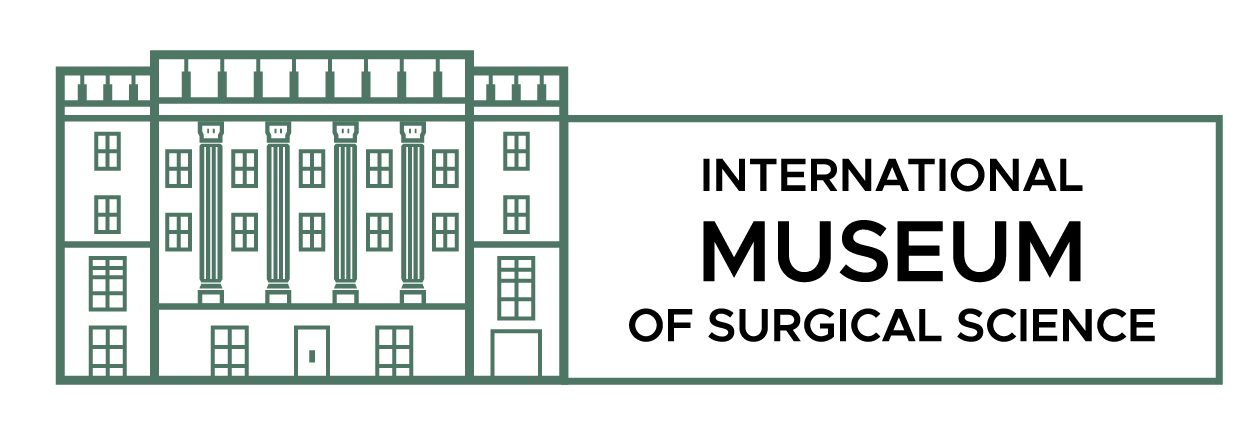Published by Claire Olszewski.
While wrapping up the first half of my internship at the International Museum of Surgical Science and preparing for summer break, I have found myself thinking about the oddities and intriguing objects I have come into contact with during my time cataloging the collection. Because of this, I would like to write a sort of retrospective where I highlight my favorites. The objects I am presenting today have almost no correlation aside from my naivety on their use and an interest in exploring them further.

After Alexander Graham Bell’s invention of the telephone by way of the liquid transmitter in 1876, Francis Blake and David Edward Hughes invented the carbon transmitter in 1878. This gave way to acoustic prosthetics. This 1935 Acousticon Model 17 hearing aid was one of the last carbon transmitter hearing devices produced. I was surprised to find electric hearing aids from the 1930’s on one of the first days of my internship because I had no idea of the history behind them. Nowadays, hearing aids are compact and covert. In the early 1900’s hearing aids were large receivers that the users would physically hold up to their ear. These speakers were connected by wire to a carbon transmitter that would amplify sound using a large battery (about the size of an iPhone) which only had the capacity to last 2-3 hours.
 The next object is not as complex, but it happens to be one of my favorites because it is the only one that actually made me cringe. I was interested in finding out what this invasive looking instrument was useful for and almost regretted my curiosity when I found out. This pair of forceps is used specifically for grasping and removing tonsils during a tonsillectomy. These long metal pincers have sharp teeth on both sides in order to puncture the tonsil and securely remove them from the mouth. In the case that hemorrhaging occurs, the forceps are left in the patient’s mouth, fastened indefinitely around the tonsil, until the risk decreases and the instrument can be removed. Though our pair is dated between 1930-1960, this instrument is still used today. Hopefully, I never need a tonsillectomy because these make me wince.
The next object is not as complex, but it happens to be one of my favorites because it is the only one that actually made me cringe. I was interested in finding out what this invasive looking instrument was useful for and almost regretted my curiosity when I found out. This pair of forceps is used specifically for grasping and removing tonsils during a tonsillectomy. These long metal pincers have sharp teeth on both sides in order to puncture the tonsil and securely remove them from the mouth. In the case that hemorrhaging occurs, the forceps are left in the patient’s mouth, fastened indefinitely around the tonsil, until the risk decreases and the instrument can be removed. Though our pair is dated between 1930-1960, this instrument is still used today. Hopefully, I never need a tonsillectomy because these make me wince.
The last object I have to share is this odd looking spiral instrument I found amongst a drawer of obstetrical forceps. I have never seen an item like this and could not imagine its utility. I found that this item is called a spiral placenta curette, which is used to extract the placenta. In many cases, the placenta is expelled from the body naturally after child birth but in special circumstances it must be manually removed. The general rule of thumb is to wait thirty minutes after child birth for the placenta to pass. If it has not breached by then, the obstetrician will use this instrument to puncture the placenta, rotate inward like a corkscrew and retract it removing the placenta. When this method does not work, it means that the placenta has grown into the uterine lining and must be surgically removed. This is important because an unexpelled placenta can cause infection or death.
Sources:
“Timeline of Hearing Devices and Early Deaf Education.” Missouri Women in the Health Sciences – Health Professions – Development of the Field of Physical Therapy, beckerexhibits.wustl.edu/did/timeline/.
Lester, John C. “Volsella Forceps for the Arrest of Hemorrhage in Tonsillotomy.” The Laryngoscope, vol. 3, no. 4, 1897, pp. 230–231., doi:10.1288/00005537-189710000-00013.
“The New Spiral Curette.” The Materia Medica Journal, vol. 1, no. 1, July 1896, pp. 68–70.
Claire Olszewski is the Permanent Collection Intern at the International Museum of Surgical Science. She graduated from Columbia College Chicago in December of 2017 with her BA in Visual Arts Management and minor in Art History. She currently works at Linda Warren Projects as a Gallery Assistant.

